This year’s Brighton Photo Biennial brought together a number of antiwar artists and photographers in an ambitious exhibition entitled Memory of Fire: the War of Images and Images of War. The curator Julian Stallabrass and staff at nine galleries and museums across southern England put together diverse displays of images of war ranging from the early twentieth century to the present day. The exhibition raised many issues concerning the nature of war and its representation, the decline of photojournalism and the role of the embedded photographer.
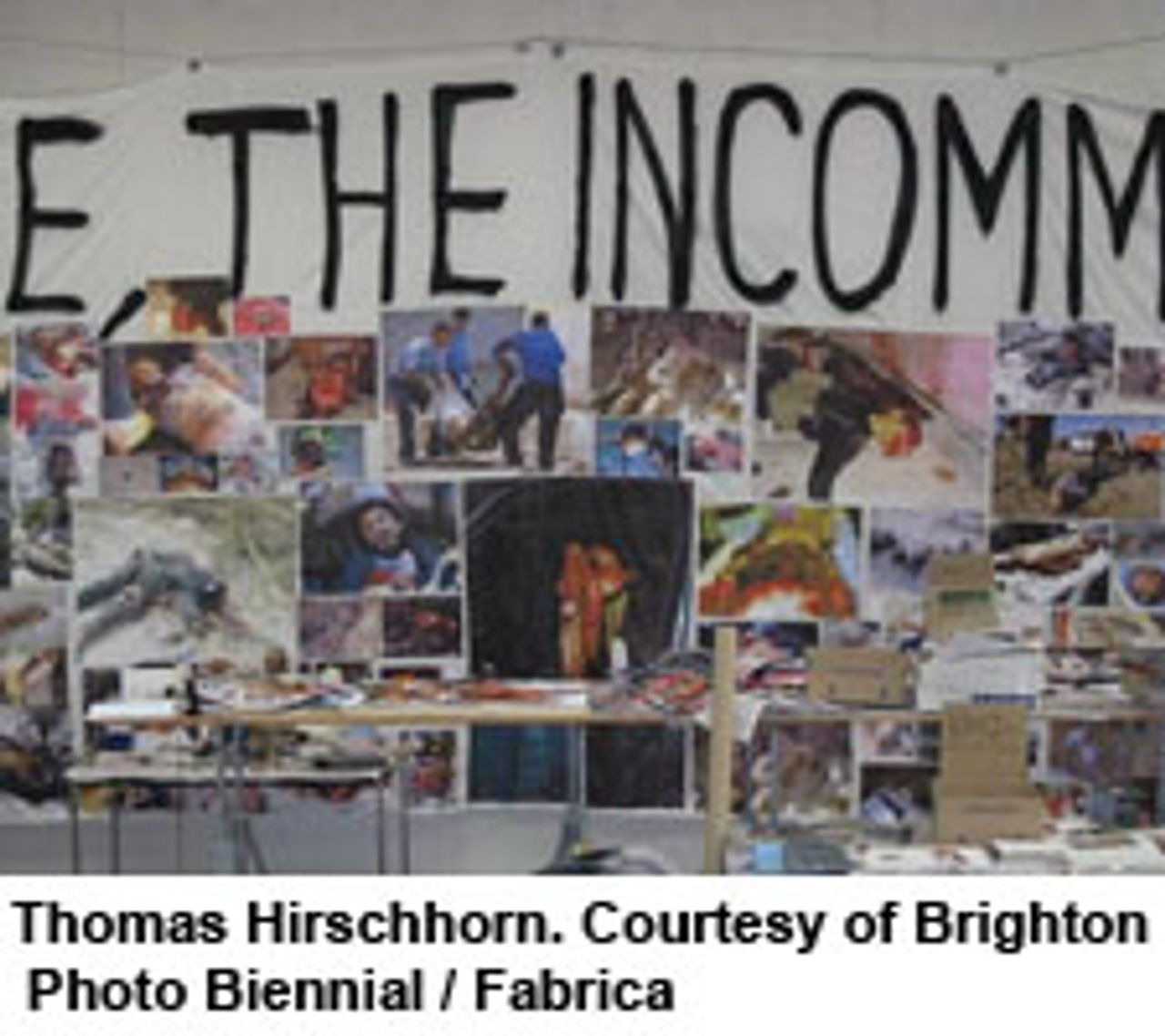 With so many venues and so many artists, it is difficult to know where to start but let’s begin with the most explicitly political artist in the exhibition, Thomas Hirschhorn. His gruesome huge banner The Incommensurable hanging at the Fabrica Gallery in Brighton, is a collage of graphic photos of mangled human flesh from the Internet or underground magazines that rarely find their way into the mainstream media. They are terrible to look at. A man with his limbs detached lies crumpled in the middle of a road. A youth sits in a car with the top of his head blown away. I felt physically sick by the time I walked the 18 metres length of the banner... many people couldn’t manage the short distance. The catalogue is right, the banner “reads as an endless parade of utter destruction, depicting bodies blown apart by modern weapons, weapons designed not to kill but to obliterate.”
With so many venues and so many artists, it is difficult to know where to start but let’s begin with the most explicitly political artist in the exhibition, Thomas Hirschhorn. His gruesome huge banner The Incommensurable hanging at the Fabrica Gallery in Brighton, is a collage of graphic photos of mangled human flesh from the Internet or underground magazines that rarely find their way into the mainstream media. They are terrible to look at. A man with his limbs detached lies crumpled in the middle of a road. A youth sits in a car with the top of his head blown away. I felt physically sick by the time I walked the 18 metres length of the banner... many people couldn’t manage the short distance. The catalogue is right, the banner “reads as an endless parade of utter destruction, depicting bodies blown apart by modern weapons, weapons designed not to kill but to obliterate.”
Hirschhorn started work as a graphic designer with the French Communist Party-linked Grapus workshop in the 1980s, producing advertisement-like political street art, but left after a number of years. He said he discovered that his work as a graphic designer meant “to do what certain people want you to do” and “the decision to be an artist is the decision for freedom.” Since then he taken to creating huge installations out of everyday materials such as cardboard, foil and plastics often bound together with reams of masking tape. Hirschhorn’s biggest and best known work World Airport, created for the 1999 Venice Biennale, consisted of a map of the world map littered with crudely constructed model aircraft emblazoned with their national flags. Around them were piled images and objects representing the global conglomerates such as Ford or Nike alongside tributes to Marxists such as Rosa Luxemburg and Antonio Gramsci. Similar contrasts can be found in Hirschhorn’s other installations.
Hirschhorn says, “I want to be courageous. An artist has to be courageous. Because he or she fights for the impossible, he or she has an impossible mission. It is impossible because there is no exit. No exit out of the world.”
What appears as frustration is evidenced by his statement, “I am not interested in ‘quality’, I am interested in ‘energy’”. It is expressed in a remorseless drive to pile on objects and images in a way that overwhelms the viewer. His latest work is meant “to fully implicate us in the realities of war waged on our behalf,” but this sentiment is wide of the mark. War is not waged on “our” behalf, but on behalf of a ruling class intent on preserving its power and privileges. Such statements, echoed elsewhere, ignore mass opposition to the Iraq war and absolve those responsible for diverting it into safe channels.
Nothing could be further from Hirschhorn’s overtly violent images than the 15 large art photographs at The Sublime Image of Destruction exhibition at the De La Warr Pavilion in Bexhill. At first glance they looked like landscape paintings, but a closer look reveals an altogether darker side.
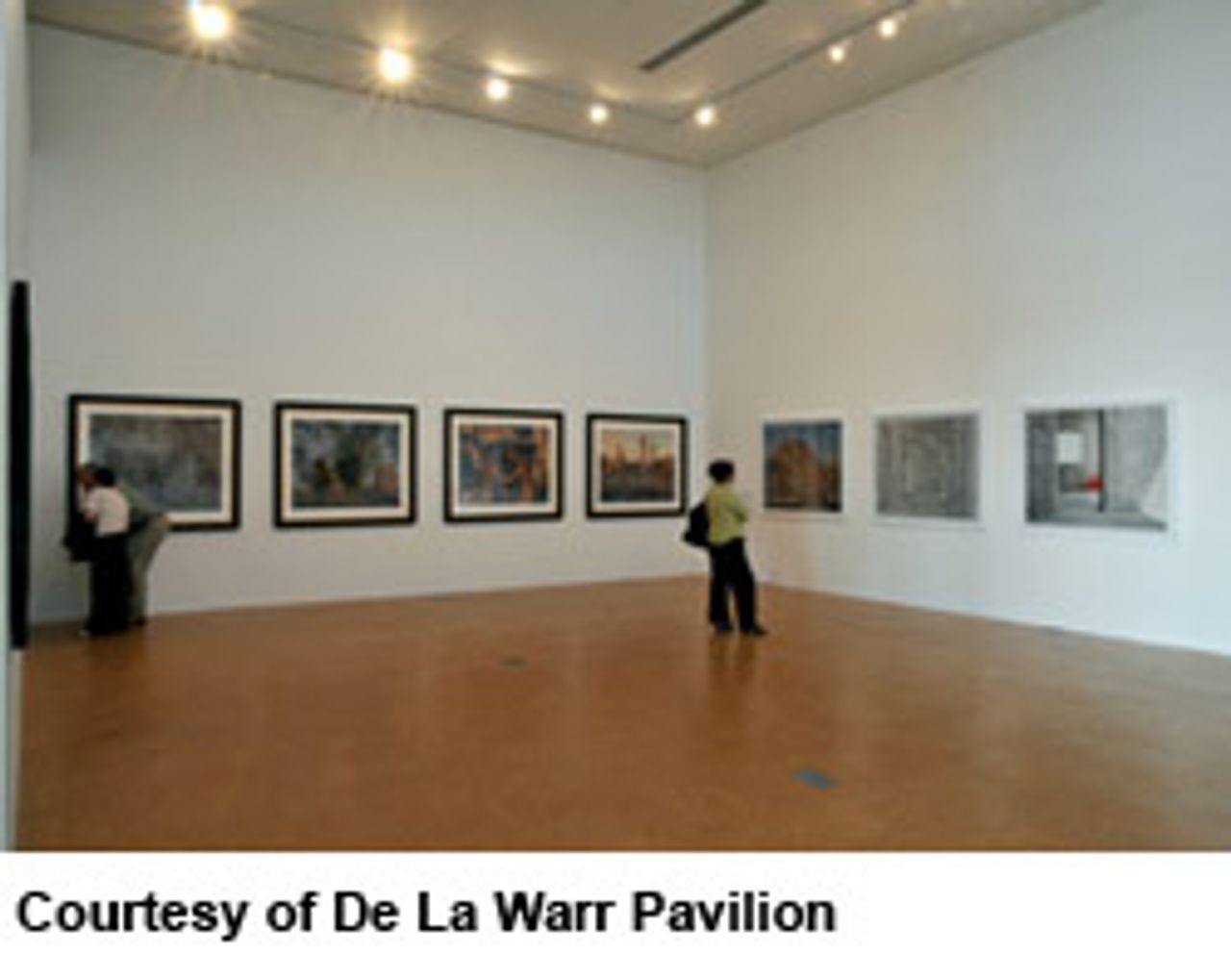
Of Simon Norfolk’s four pictures, taken during his 2003 visit to Iraq as an embedded journalist, the most memorable is his North Gate of the City showing the arched entrance to Baghdad alongside swaying trees under a blue clouded sky. It all looks idyllic until you spot the destroyed tanks and waterlogged tracks. Have a look at the remaining photos―a blood-splattered wall, burnt-out filing cabinets in an Iraqi ministry building and the remains of a statute of Saddam Hussein―together with much of Norfolk’s other work on www.simonnorfolk.com.
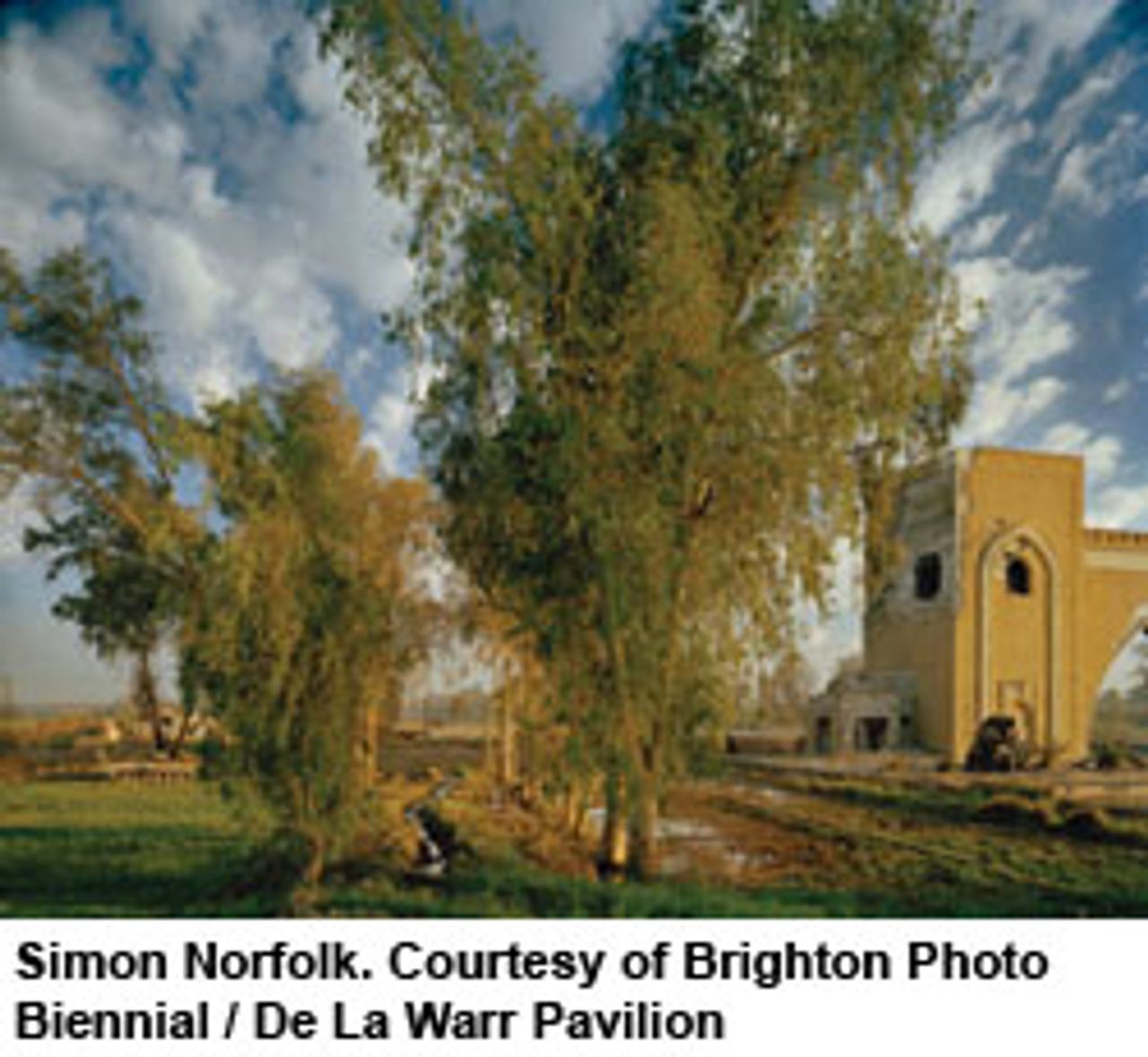 Norfolk contrasts his photos to the classical ruins in the paintings of the eighteenth century artists, Nicolas Poussin and Claude Lorrain, seeing them as “philosophical metaphors about the foolishness of pride, about awe and the sublime, about the power of God and most importantly to me, the vanity of Empire.” His photographs since 9/11 seek to remind us of “a very special time to be thinking about the making of a new global empire, the brutality necessary for its construction and what the ruin might mean for all of us.”
Norfolk contrasts his photos to the classical ruins in the paintings of the eighteenth century artists, Nicolas Poussin and Claude Lorrain, seeing them as “philosophical metaphors about the foolishness of pride, about awe and the sublime, about the power of God and most importantly to me, the vanity of Empire.” His photographs since 9/11 seek to remind us of “a very special time to be thinking about the making of a new global empire, the brutality necessary for its construction and what the ruin might mean for all of us.”
Norfolk left an academic career to become a photojournalist and his pictures of Northern Ireland’s “Troubles”, the poll tax rebellion and race attacks appeared in a number of left-wing publications. Since then, he has concentrated on gallery exhibitions and publishing books such as “For Most Of It I Have No Words,” depicting landscapes of places associated with genocide like Auschwitz, Cambodia and Rwanda.
Norfolk underestimates his work’s impact when he says, “Intellectually, I know I can’t change George Bush’s mind but, when I am taking the pictures, I have to believe they will have an effect, otherwise I wouldn’t be able to do the work.” Bush’s mind might be a closed book, but so many people during my visit were visibly moved.
Many of the places photographed by Norfolk have also been the subject for Adam Broomberg and Oliver Chanarin. On one wall, three photographs, arranged like a religious triptych, show a barren desert landscape. The photo on the left shows a newly built town glowing ethereally in the morning sun like a vision of Blake’s Jerusalem... but it is Ma’ale Adumim, the second largest Israeli settler town in the West Bank, which according to a 2005 United Nations Human Rights report is one of “three major settlement blocs ... [that] ... will effectively divide Palestinian territory into cantons or Bantustans.”
Again, it was fascinating to watch how the response of visitors changed once this became apparent.
Broomberg and Chanarin also had a set of photos from their Chicago project (see http://www.choppedliver.info/) on the opposite wall of the gallery, depicting scenes from a mock Arab town built by the Israeli Defence Force in the middle of the Negev Desert that is used for combat training.
Broomberg and Chanarin are well aware of the way the media excludes material that “undermines the war effort.” As judges at this year’s World Press Photo awards, they pointed out that “images from contemporary conflict zones showing the real effects on the human body were conspicuously absent and the few that were there had never been published in the media. This illustrates a tacit agreement that exists between photographers, editors and advertisers.”
“The second thing we noticed is that most of the images of conflict that were submitted were produced by embedded journalists who... have exchanged access to the battlefield for self-censorship and outside scrutiny,” they added.
Having understood this, their latest work, The Day Nobody Died (see also http://www.choppedliver.info/) comes as something of a surprise. Using a 50-metre long, three-quarter metre wide roll of photographic paper in a lightproof box on their June 2008 embedded trip with British Army units in Afghanistan’s Helmand Province the pair recorded a series of events from the deaths of soldiers to more “mundane” moments such as a visit by the Duke of York by unrolling a section of the film and exposing it to the sun. The result is an abstract band of random patterns and coloured hues.
Broomberg and Chanarin justify the project saying, “We somehow wanted to place the responsibility, the burden of imaging, back on the viewer.” This seems to be an abdication of the artist’s own responsibility.
The issue also surfaced when the photographer Julian Germain gave a talk about his installation, Memorial, at the Aspex gallery in the naval city of Portsmouth. In the past Germain has combined amateur photos with his own to great effect to show the devastation wrought by the closure of the Consett steel works and the squalor of life in the shanty towns of Latin America. He demonstrates much sensitivity and respect towards his working class subjects.
For his latest work, Germain constructed a 25-metre x-shaped low display cabinet containing the photo albums of military personnel and a couple of screens showing videos, including one shot by sniper Sergeant Steve Armon during a tour with the Royal Anglian Regiment in Afghanistan. It was disturbing to hear the troops whooping with delight at bombers called in to obliterate the enemy and even more so to hear Armon admit at Germain’s talk that he developed a love for photography whilst on undercover surveillance in Northern Ireland and is responsible for censoring the photos of soldiers in his platoon. “The British Army didn’t want photos of us shovelling up bodies in Iraq getting out,” he told the audience. When asked if the use of unmediated material like this bothered him, Germain answered that he has always tried to be apolitical. This abdication of responsibility is particularly damaging and limiting in a situation where the British government is desperate to justify its military adventures.
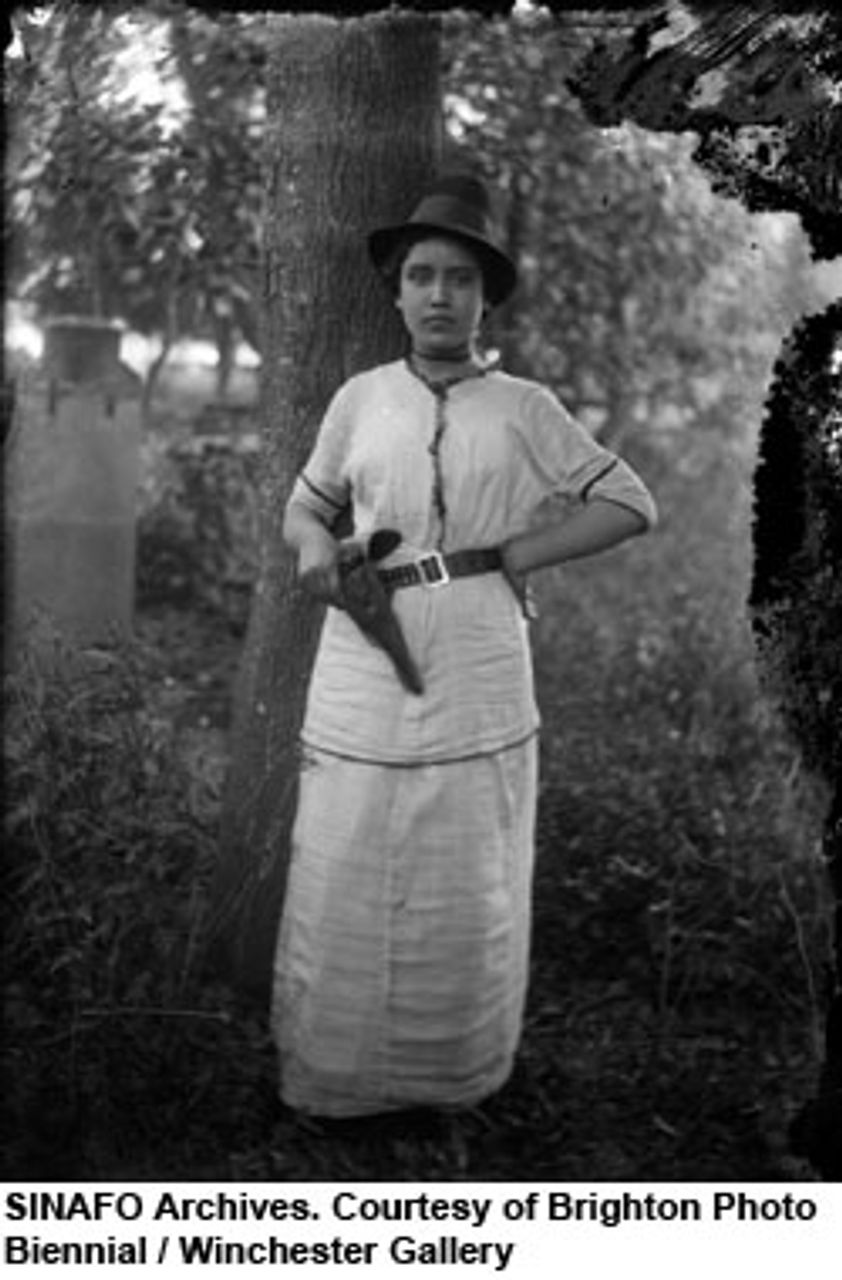
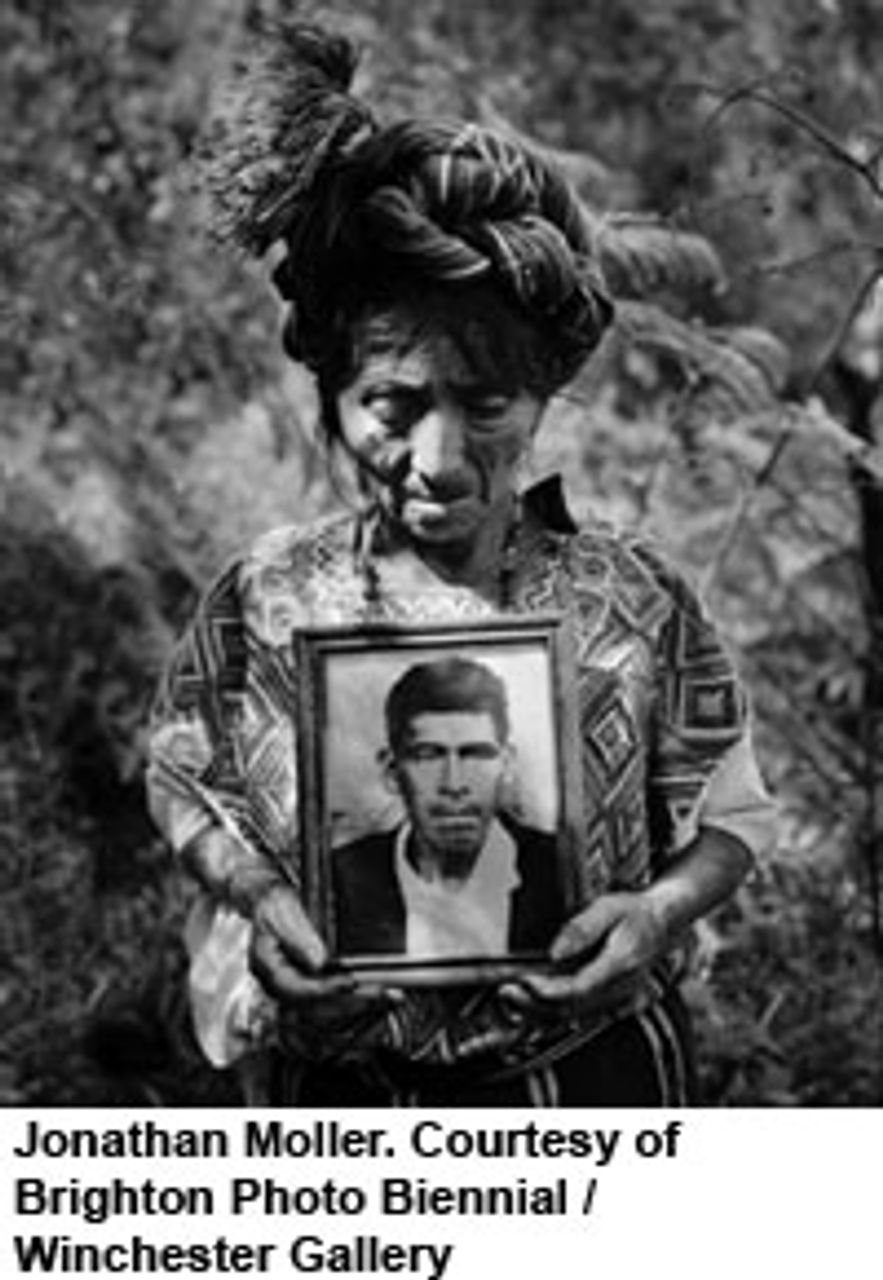 At the Winchester Gallery the exhibition, Photography and Revolution: Memory Trails through the Latin American Left, started with images from the Mexican Revolution. A particularly poignant photo, Soldadera, is of a young woman with a gun in her belt who exudes a self confidence and dignity rarely found in later images, many of which, like Jonathan Moller’s Clara holds photo tend to see the oppressed purely as victims. The young soldadera also contrasted (perhaps unintentionally) with the last photo in the exhibition—a glorification of Venezuelan President Hugo Chavez, the actor Sean Penn at his side, riding in his limousine waving aloft a picture of Che Guevara.
At the Winchester Gallery the exhibition, Photography and Revolution: Memory Trails through the Latin American Left, started with images from the Mexican Revolution. A particularly poignant photo, Soldadera, is of a young woman with a gun in her belt who exudes a self confidence and dignity rarely found in later images, many of which, like Jonathan Moller’s Clara holds photo tend to see the oppressed purely as victims. The young soldadera also contrasted (perhaps unintentionally) with the last photo in the exhibition—a glorification of Venezuelan President Hugo Chavez, the actor Sean Penn at his side, riding in his limousine waving aloft a picture of Che Guevara.
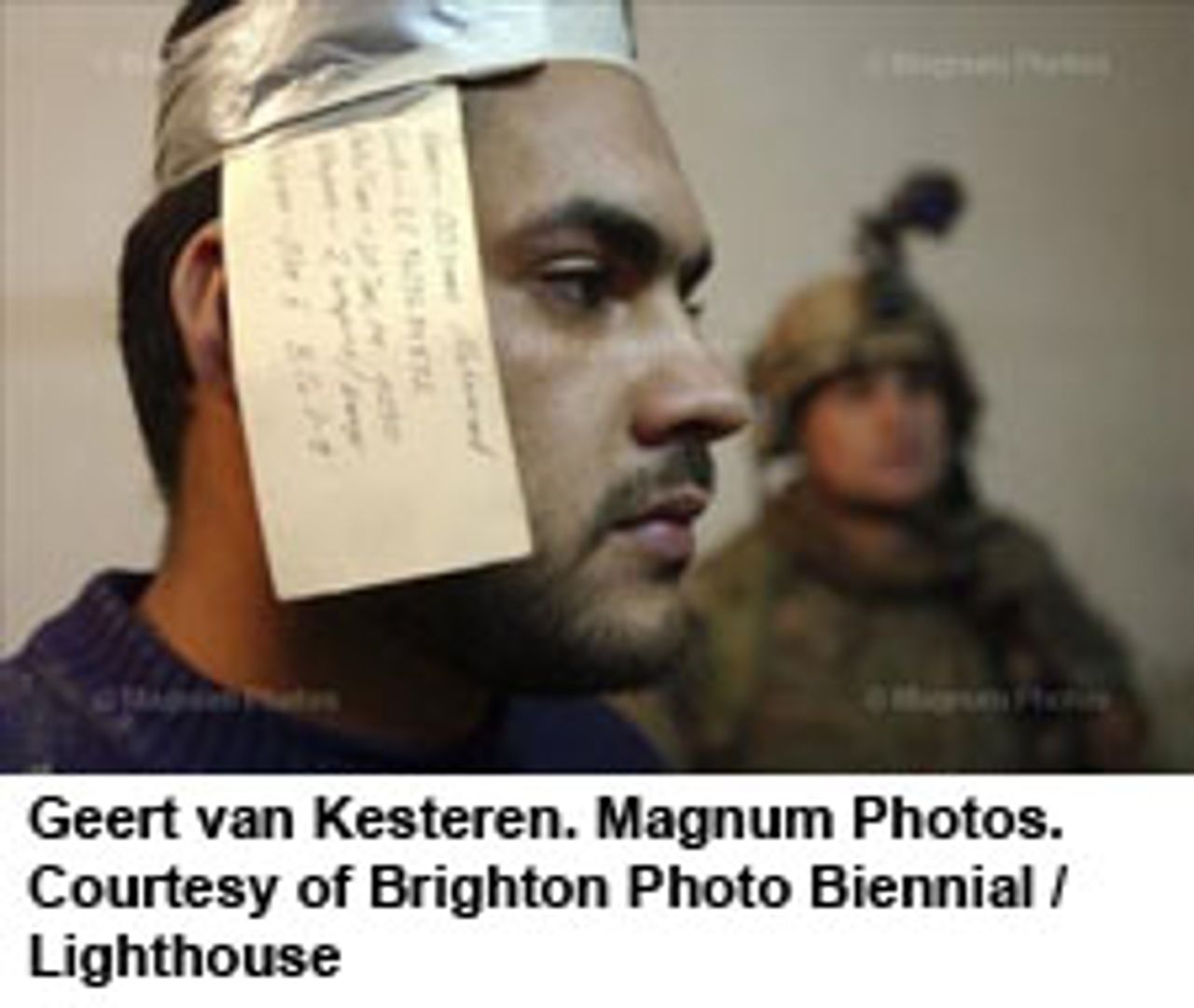 Honourable mention should also be made of a few other photojournalists. Geert van Kesteren’s Why, Mister, Why? and Baghdad Calling exhibition at Brighton’s Lighthouse gallery tries to overcome the limitations of embedding with his photos of trussed-up Iraqis and US troops performing house searches. His video of exiled Iraqis explores the rapid disillusion that set in after the US invasion and the troops’ attempts to live life as normally as possible amongst the chaos.
Honourable mention should also be made of a few other photojournalists. Geert van Kesteren’s Why, Mister, Why? and Baghdad Calling exhibition at Brighton’s Lighthouse gallery tries to overcome the limitations of embedding with his photos of trussed-up Iraqis and US troops performing house searches. His video of exiled Iraqis explores the rapid disillusion that set in after the US invasion and the troops’ attempts to live life as normally as possible amongst the chaos.
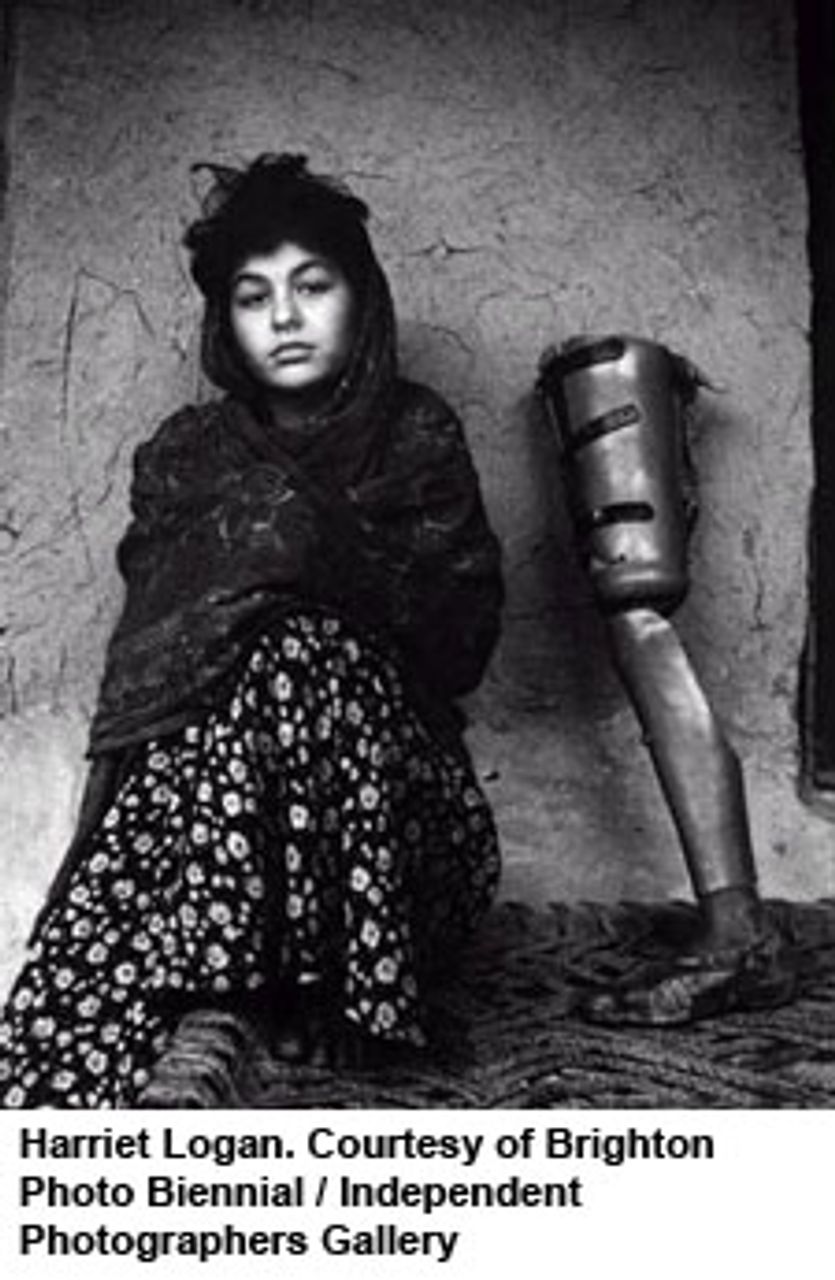 Harriet Logan’s photos at the Independent Photographers Gallery in Battle date from her Sunday Times sponsored assignment to Afghanistan in 1997, during Taliban rule, and another visit in 2001, after the US-led invasion. Shot on black and white film they are striking images of Afghan women, condemned to poverty because of the ban on women working outside their homes, or children like Fahrida injured by landmines. It was interesting to hear some pining for the days of greater freedom under Communist rule and others expecting it under the new US occupation. As the catalogue explains: “The risk of having their photographs taken was even stronger as the Taliban considered photography as a form of idolatry. But the women risked their lives in order for these stories to be heard by the outside world.”
Harriet Logan’s photos at the Independent Photographers Gallery in Battle date from her Sunday Times sponsored assignment to Afghanistan in 1997, during Taliban rule, and another visit in 2001, after the US-led invasion. Shot on black and white film they are striking images of Afghan women, condemned to poverty because of the ban on women working outside their homes, or children like Fahrida injured by landmines. It was interesting to hear some pining for the days of greater freedom under Communist rule and others expecting it under the new US occupation. As the catalogue explains: “The risk of having their photographs taken was even stronger as the Taliban considered photography as a form of idolatry. But the women risked their lives in order for these stories to be heard by the outside world.”
Finally it was good to see the photos of veteran photojournalist Philip Jones Griffiths, who died in March this year, along with many photos taken by other professionals and amateurs at the Brighton University exhibition Iraq through the lens of Vietnam. A subsidiary display at the Pallant House Gallery in Chichester was devoted to Griffith’s Agent Orange set of photos together with a short video of the children who are still being born with deformities due to the defoliant used by the United States during the Vietnam War. It was a fitting tribute to a man who helped bring the atrocities of the war to a wider public and followed the plight of the Agent Orange children to the last days of his life.
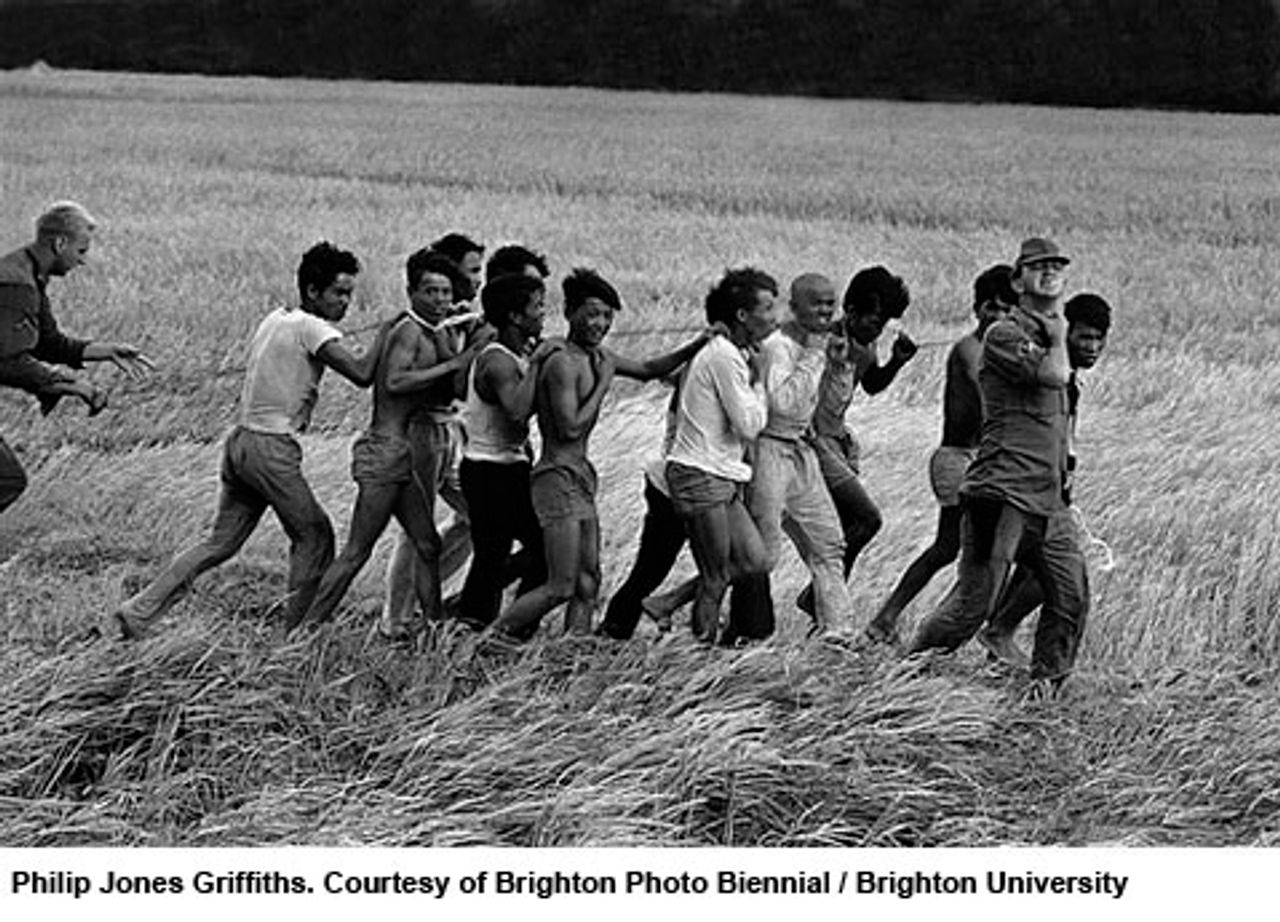
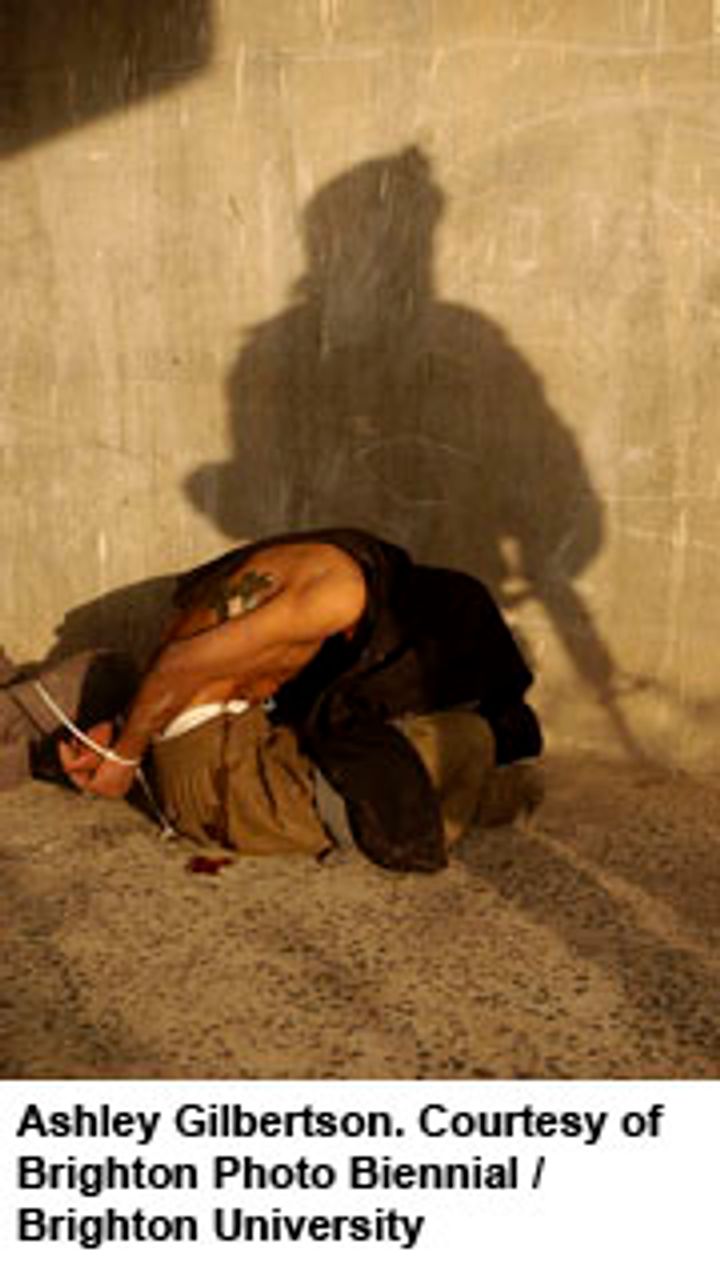 The curator of the Brighton Biennial, Julian Stallabrass, contrasts the work of people like Griffiths—“the kind of photography that galvanised the anti-war movement around the world”—to the situation today. He cites as reasons: the way the state stage manages events like the Iraq “shock and awe” campaign for an uncritical media; the trivialisation brought about by commercial competition; the practice of embedding that increases pressure for photographers to self-censor; and the all-pervasiveness of new technology, such as mobile phones, that encourages amateurs and undermines the status of professionals. He says, however, “the most fundamental factor... that separates our world from that of the Vietnam era is the lack of an opposition with a cogent world view that could assemble the evidence—words, pictures and video—into a condemnation of the war that could not be ignored, that would gnaw at us and torture us as it did many in the late 1960s.”
The curator of the Brighton Biennial, Julian Stallabrass, contrasts the work of people like Griffiths—“the kind of photography that galvanised the anti-war movement around the world”—to the situation today. He cites as reasons: the way the state stage manages events like the Iraq “shock and awe” campaign for an uncritical media; the trivialisation brought about by commercial competition; the practice of embedding that increases pressure for photographers to self-censor; and the all-pervasiveness of new technology, such as mobile phones, that encourages amateurs and undermines the status of professionals. He says, however, “the most fundamental factor... that separates our world from that of the Vietnam era is the lack of an opposition with a cogent world view that could assemble the evidence—words, pictures and video—into a condemnation of the war that could not be ignored, that would gnaw at us and torture us as it did many in the late 1960s.”
This analysis is an important insight. A “cogent world view” is indeed necessary for the production of serious art. Today the crisis in the world economy provides the objective conditions for developing an international socialist perspective within broad layers of the population—the only remedy to create a future without wars and transformed social relations. Artists must see themselves as making a vital contribution to that endeavour.
